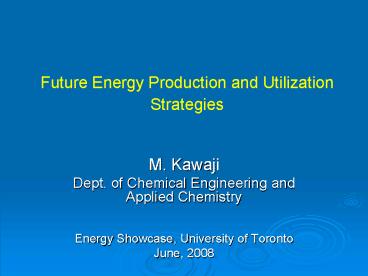Future Energy Production and Utilization Strategies - PowerPoint PPT Presentation
1 / 16
Title:
Future Energy Production and Utilization Strategies
Description:
Stop climate change by reducing consumption of fossil fuels and emission of GHG ... Chimney. from GE-Hitachi. A new design by GE-Hitachi ... – PowerPoint PPT presentation
Number of Views:70
Avg rating:3.0/5.0
Title: Future Energy Production and Utilization Strategies
1
Future Energy Production and Utilization
Strategies
- M. Kawaji
- Dept. of Chemical Engineering and Applied
Chemistry - Energy Showcase, University of Toronto
- June, 2008
2
Sustainable Energy Technologies
- Stop climate change by reducing consumption of
fossil fuels and emission of GHG - Sustainable energy technologies
- Nuclear, Solar, Wind, Ocean, Geothermal Power
- Biofuels from biomass
- Hydrogen and Fuel Cells
- Electric vehicles
- Electrochemical Energy Storage
- Energy Efficiency and Conservation
- Clean Coal with CO2 Capture and Sequestration
3
(No Transcript)
4
- Produce more electricity from CO2 emission- free
sources - Nuclear
- Solar and wind large batteries
- Small and large electricity storage systems
- Plug-in hybrid cars and all electric vehicles
- Store off-peak electricity to be used in peak
hours - Enable renewable energy sources (intermittent)
5
Source of Electricity in Canada
Electricity Generation in Canada, 2003
Total 567 TW.h (Source CEA)
- Ontario (2005), Nuclear - 51, Hydro - 22, Coal
- 19, Natural gas - 7, Other - 1 - Quebec (2002), Hydro - 96.7, Nuclear - 2.3, Oil
- 0.5, Biomass - 0.3, Natural gas - 0.2, Wind
- 0.1 - Alberta (2008), Coal - 48.8, Natural gas -
38.4, Hydro - 7.1, Wind - 4.1, Biomass - 1.5
6
Source of Electricity in the US
3821 billion kW-hrs (2005)
- By 2030, US demand for electricity is expected to
grow by 40
7
Renaissance of Nuclear Energy
nuclear energy is the only large-scale,
cost-effective energy source that can reduce
emissions while continuing to satisfy a growing
demand for power and these days it can do so
safely by Patrick Moore, Greenpeace
8
Nuclear power
- 250 PWRs, 100 BWRs, 30 CANDU reactors
operating and 34 reactors under construction
around the world - 2 new reactors to be constructed in Ontario at
Darlington - New reactors in Alberta and Saskatchewan?
- In the US, 100 reactors currently operating and
22 COL applications already filed or will soon be
filed with USNRC for constructing 30 advanced
reactors by 2030
- ACR-1000 by AECL
- ABWR by GE, Hitachi and Toshiba (Design
certification completed) - AP-1000 by Westinghouse (certification completed)
- ESBWR by GE-Hitachi (applied)
- US-EPR by Areva (applied)
- US-APWR by Mitsubishi Heavy Industry (applied)
9
Nuclear Energy of Total Electricity
2006 Potential for Increased Deployment
10
Future Opportunities and Challenges for Nuclear
Energy
From DOEs Gen. IV Nuclear Energy Initiative
Program
ACR-1000 ESBWR AP-1000 US-EPR, US-APWR
- Opportunities
- Growing demand for electricity (40 increase
expected in the next 20 years) - Sharp increases in prices of natural gas and oil
- Increased emphasis on environmentally clean energy
- Challenges
- Regulatory uncertainty
- Financing
- Availability of human capital
- Nuclear waste management
11
ACR1000
- Advanced CANDU reactor at 1200 MWe
- Use of light water as primary coolant
- Enhanced safety due to negative void
coefficient, passive shutdown and passive safety
systems - Can burn other fuel types such as mixed oxides
(MOX) and thorium fuels - Approximately 60 reduction in spent fuel
quantities
12
Economic Simplified Boiling Water Reactor (ESBWR)
- A new design by GE-Hitachi
- Natural circulation cooling of a reactor core
- Passive safety systems
Chimney
from GE-Hitachi
13
Spent Nuclear Fuel
- On-site dry storage capacity available for gt 50
years - Ultimate disposal sites and technologies can be
developed and tested in time - Reprocessing and recycling technologies are
available
14
Energy from RenewablesCarbon-free but
Intermittent
(from S. Banerjee, 2008)
15
Thank you.
16
US ENERGY PRODUCTION

